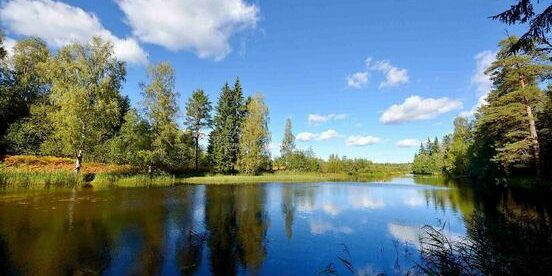
What is an ecosystem pond? And how does it work? What makes an ecosystem pond different from a pool? Is one pond better than another? Here we’ll explore the terms and definitions of this style of pond, and how it works. But before we do that, let’s take a step back, to a place away from the hustle and noise of cities, a place far from the dirt and smog of factories and industries. To a beautiful lake.
What do you see? It’s beautiful! The entire atmosphere seems relaxed and peaceful. But if you wait silently, you’ll see, hear, and feel more than you imagined. Cattails rustle in the breeze; lily pads float serenely. Then a bird chirps. A fish splashes, and a frog lets out a melancholy croak as he dives into the water. Suddenly you realize that all around you, everything is alive! Minnows race in the shallow waters. Dragonflies skim the surface of the water. A family of ducks swims and dives through the water. Waterstrider bugs row madly across the still water, swallows dip and fly overhead, and in the gentle breeze that moves across the water you hear the distant cry of a hawk. The tall trees’ long roots grow right down into the water, in search of the life it gives; even the gentle flowers along the water nod in celebration of Life. This is Life, unmarred by everything man has done to make our world better, faster, easier. This is a natural ecosystem.
All human civilizations evolved around water. It is the very sustenance of all the life we know. But in our quest to make life better, we rid ourselves of everything we think we do not need. So we build structures. And Cities. And we first purified, then sterilized our water. And we got rid of the muck, and the bugs and everything we thought we didn’t want. And yet, at the heart of every city, the center of every town, we find a desperate attempt to bring back the life we somehow lost.
It captures the feeling of being a child in its laugh; the sensation of life in its splash. We are inexorably drawn to it. And the concrete fountain stands not to fulfil our love of water, but to remind us that we want something more. And so we travel to the beaches, and vacation to the coasts of water wherever we find it. But then we leave again, with only a sunburn and an ill-fated souvenir that will never quite capture the magic of that day. If only we could capture the essence of the woodland lake, if we could bottle of the sound of the river and package the beauty of nature at rest and take it back with us to our homes.
Enter the ecosystem pond.
An ecosystem pond is a pond or stream designed to function following the patterns of nature. No harmful chemicals, no complex filter system, no chlorine. These natural beauties are created to embrace and enhance life on every level, from the graceful plants that add color around and in the water to the beautiful fish that swim in the shallows and the birds that bathe at the water’s edge. Welcome to the pond life.
These ponds all follow similar construction theory, but they can be designed to fit almost any backyard size or area. Even a small area, indoor or outdoor, can be transformed with the beauty and life of an ecosystem pond.
But how is this done? A freshwater ecosystem has almost endless players that contribute to the symphony, but we’ll look at a few of the key players that are almost universal, from the smallest patio bowl pond to the endless Everglades.
Circulation.
Circulation is vital to pond life. In a naturally-occurring system, circulation usually happens by the natural flow of rivers or creeks. In a man-made system we recreate this with a simple skimmer and waterfall system. This circulation does several things. First, the moving surface water effectively skims floating debris from the surface of the pond, removing excess leaves and litter before they sink to the bottom. Circulation also helps keep the oxygen in the water at healthy levels for the plants and fish. With proper circulation, no brackish water will ever become a breeding ground for those pesky mosquitos.
Filtration.
Pond filtration can be divided into two categories, Mechanical Filtration and Biological Filtration. Mechanical Filtration can be thought of as the physical removal of debris from water. The skimming of the circulation system plays a huge part in mechanical filtration. In a constructed ecosystem, we enhance this system by using a skimmer basket to remove leaves and debris, and filter mats to aid in separating tiny pieces of debris from the flow of water. The same skimmer that holds these functions also conveniently houses the pump that provides circulation for the pond. Biological filtration is the removal of excess nutrients from the water. These nutrients are invisible and so seem trivial, but a nutrient imbalance is the beginning of many problems, from cloudy water to prolific algae blooms and poor fish health. Healthy bacteria play a major role in biological filtration; these bacteria break down and devour sediments and debris and improve water clarity. The biological filtration acts as the digestive system of a pond, and these healthy bacteria strains are carefully selected by biologists for their safety to all humans and animals.
Fun Fact: The human body has over one hundred billion healthy bacteria in it! (yeah, that’s 100,000,000,000) A pond without healthy bacteria can get a belly ache, just like its owners.
Plants.
Many people assume plants are simply a cosmetic to enhance pond life; however, they are vital to a flourishing ecosystem. Aquatic plants pull nutrients out of the water to grow. If these nutrients remain in the water, they will allow algae to flourish. So having established plants in and around the pond will starve unwanted algae out of the ecosystem. Plants also put oxygen into the water in exchange for the nitrates and carbon dioxide they pull out. This greatly boosts fish health; they need oxygen in the water to live. Plants also provide cover for small pond life to flourish in, from the dragonflies who control bug populations, to the microbes who silently consume debris and waste from the pond.
Fun Fact. While mosquitos cannot reproduce in the moving water of a correctly designed ecosystem pond, Dragonflies prefer this environment for breeding. These tiny carnivores can eat up to a hundred mosquitoes in a single day!
Fish.
These silent friends do much more that just exist and look beautiful. Just as the plants pull carbon dioxide out of the water and release oxygen back in for the fish, the fish give back to their beneficiaries. They consume oxygen in the water, but release carbon dioxide back for the plants. Fish waste acts as fertilizer to the many plants who thrive in these mutual waters. Many fish act as ever-on-duty cleaners, eating algae growth off rocks and gravel in the pond.
Fun Fact: Koi Fish, long considered the king of the water garden fish world, are bottom feeders. This means they are best suited to eat from the bottom of your pond; cleaning algae from gravel is as natural to them as eating a sandwich is to us.
Rocks and Gravel.
Rocks are important to the construction of an ecosystem pond. They provide stability in construction and add coves of shelter for fish from natural predators from above. What little algae grows on the surface of rocks and gravel becomes a food source for the fish. Rocks and gravel also greatly increase the surface area of growing space for the bacteria that digest pond waste; these microscopic workers need to attach to a surface to live.
There are many more finessed parts of a properly functioning ecosystem pond, but these parts together make up the body of what a freshwater ecosystem is and how it works. Coming together they can create all the life, peace and beauty of the world’s finest ecosystems.
Welcome to pond life; you belong here!
